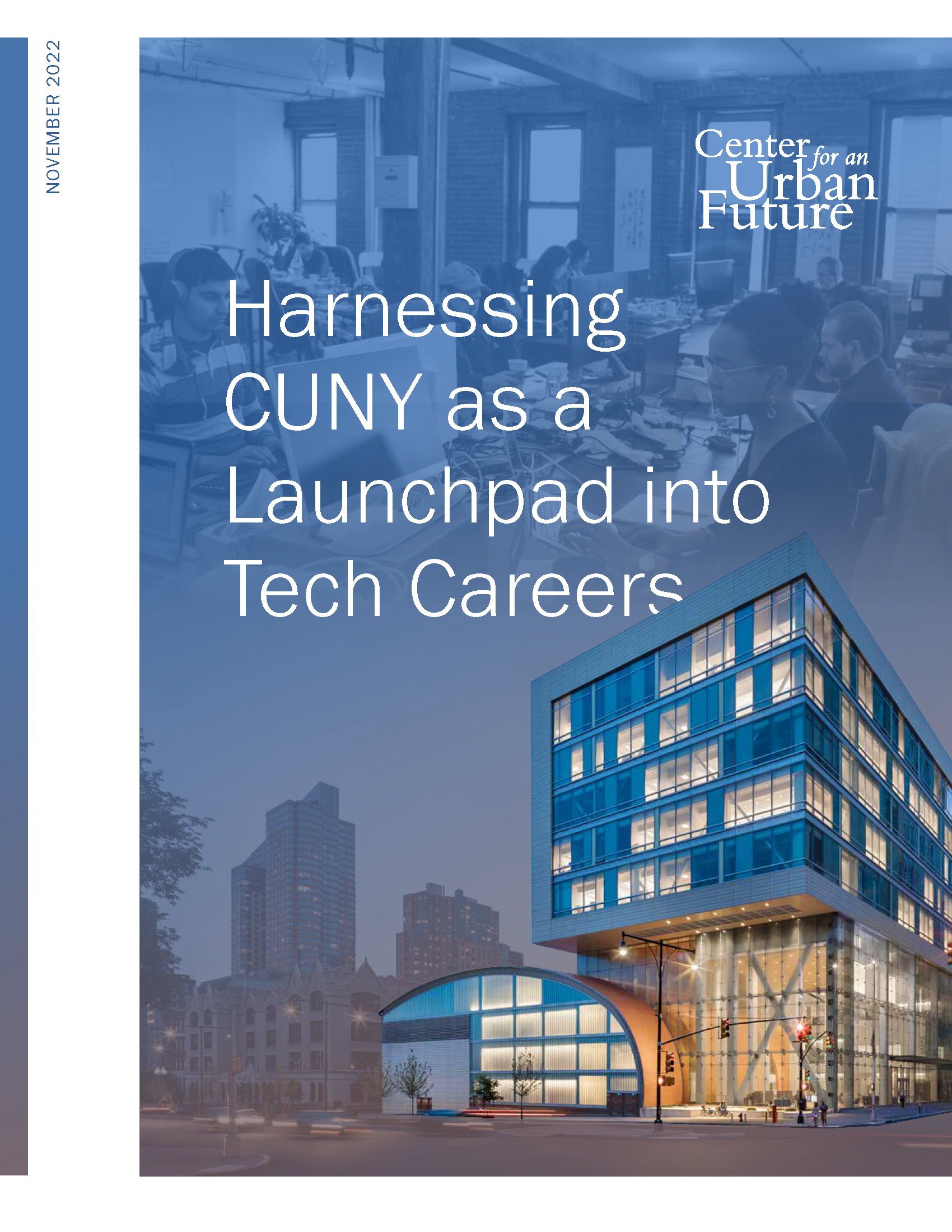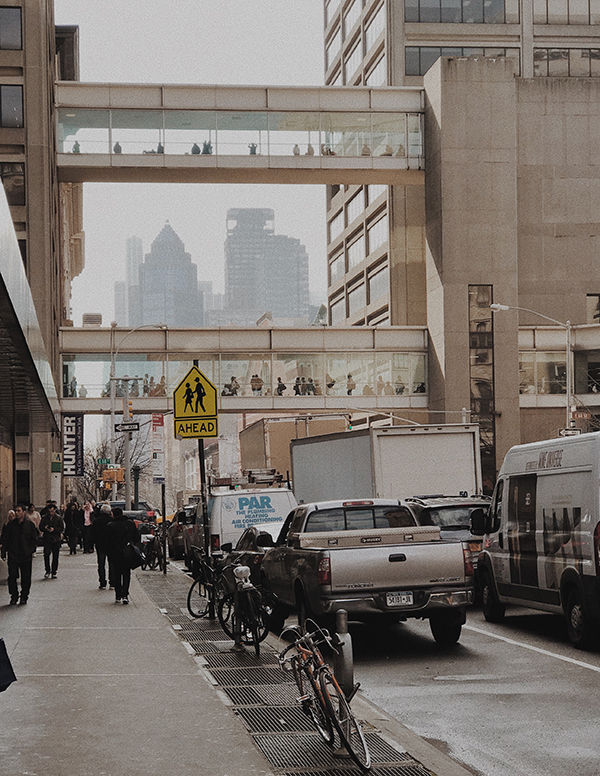Part 1 in our research series: Diversifying the Workforce in High- and Middle-Wage Industries that are Growing in New York City
In recent years, there has been a commendable focus on increasing the diversity of New York City’s tech workforce, with city officials, industry leaders, and workforce training organizations rolling out important new programs to help expand access to opportunities in the industry. Initiatives such as the NYC Tech Talent Pipeline, Computer Science for All, CUNY 2X Tech, and several new nonprofit-run programs have emerged to address the underrepresentation of New Yorkers of color in the tech workforce, a vital step toward expanding pathways into these well-paying, fast-growing jobs.1
However, for New York City to succeed in building a more equitable economy, it will be essential to extend a similar strategy to other growing industries with middle- and high-wage jobs that, like tech, employ alarmingly few New Yorkers of color. One place to start is the advertising sector.
Advertising has been one of the city’s fastest-growing industries, experiencing a 49.5 percent increase in jobs over the past two decades—growing from 46,700 jobs in December 2003 to 69,800 jobs in December 2023. This surge in employment outpaced the overall private sector job growth rate of 36.7 percent over the same period.
.jpg)
Advertising is also one the industries in which New York City has a major competitive advantage. In December 2023, the city was home to an incredible 13.4 percent of all advertising jobs nationwide, up from a 10.9 percent share twenty years ago.2
Advertising also boasts some of the highest wages among growing industries; for example, the median annual income for the advertising industry is $91,712 a year, nearly double the city-wide private sector annual median income of $55,108. Furthermore, New Yorkers of color employed in advertising earn much higher wages, on average, than in other industries, although disparities remain. For Asian workers in advertising, the median annual wage is $94,203, for Hispanic workers in advertising, the median annual wage is $75,362, and for Black workers in advertising, the median annual wage is $72,064. Wages for non-white workers are much higher in advertising than they are in most other parts of the city’s economy; for Asian workers, the citywide median wage is $52,988, the citywide median wage for Black workers is $44,237, and for Hispanic workers it is $39,830.3
Advertising hasn’t been the only industry to register significant employment growth in recent years. But it is one of relatively few high-wage sectors that had sustained growth over the past decade. Many of the city’s fastest-growing sectors offer significantly lower wages. For instance, while home health care jobs in New York City have increased by 560 percent over the past two decades, the median annual wage of the industry is $30,354. Food services, another high-growth industry, grew its jobs by 82 percent over the last two decades, but the median annual wage is also $30,211. Jobs in the social assistance industry climbed 81 percent in the same period but the median annual wage of community and social service jobs is $39,000.4
Despite all it has going for it, the advertising industry remains one of the least diverse sectors in the city. In 2022, Black workers accounted for only 7.7 percent of the city’s advertising workforce, significantly lower than their 20.7 percent share in the city’s total workforce and 21.9 percent share of the city’s overall population. Similarly, Hispanic New Yorkers constitute 27.6 percent of the city’s total workforce and 29.1 percent of the city’s overall population but make up only 14.8 percent of the advertising industry. Asian workers represent 15.4 percent of the city’s total workforce but hold 10.6 percent of advertising jobs.
Fortunately, there has been progress in diversifying the industry’s workforce in recent years. The share of non-white workers in advertising has risen by 5.8 percentage points since the turn of the century, from 27.9 in 2000 to 33.7 percent in 2022. However, this increase lags the strides made in the city’s overall workforce, in which the share of non-white workers rose by 12.8 percentage points in the same period (from 51.4 to 64.2 percent).5
Creating a more diverse workforce in New York’s advertising industry will require a similar focus—and similar set of public and private investments—to the efforts undertaken during the past decade to expand access to tech careers. Employers in the industry will need to step up with new and enhanced commitments to recruit and hire New Yorkers of color and help young people explore opportunities in the industry and access paid internships. More advertising leaders should support industry-led initiatives like those incubated by the Ad Club of New York Foundation and partner with the city’s two current industry-aligned high schools the Manhattan Early College School for Advertising and the High School for Innovation in Advertising and Media. However, the Adams administration should help spark and sustain the deeper changes and new investments that are needed.
Leaders from NYCEDC and the Mayor’s Office of Talent and Workforce Development should establish an Advertising Talent Pipeline, modeled on the Tech Talent Pipeline. The first step is to create a working group of leaders from the advertising sector, workforce organizations, and the City University of New York (CUNY) charged with developing a set of initiatives to increase pathways into the industry and expand internship opportunities. As part of this, city and industry leaders should attempt to promote, replicate, and scale up industry efforts that are already working. These include the 4A’s Foundation’s Multicultural Advertising Intern Program, and promising steps taken by Horizon Media to combine career exploration in high schools, paid internships that lead to jobs, and an in-depth fellowship program focused on preparing people for advertising careers.
Expanding access to advertising careers might also include encouraging company leaders to embrace skills-based hiring—the practice of doing away with the college degree requirement for some positions. Doing so would help extend advertising industry opportunities to New Yorkers without a traditional college degree. In 2022, only 7 percent of jobs in the advertising industry were held by adults without at least a bachelor’s degree, even as the industry has a long history of celebrating creative innovators from nontraditional academic backgrounds.6
To make progress toward a more equitable and inclusive economy in New York, it will be crucial to expand access to careers in several middle- and high-wage industries that are growing but have flown under the radar of the city’s workforce strategy. Advertising is one sector where progress is both needed and eminently possible. By replicating the successful strategies employed in the tech sector, city leaders can achieve success in creating new pathways for underrepresented communities into well-paying careers.
Endnotes
1 Center for an Urban Future, “Boosting Tech Career Success for CUNY Students: Doubling Down on CUNY 2X Tech,” October 2023, https://nycfuture.org/research/doubling-down-on-cuny-2x-tech.
2 Center for an Urban Future analysis of data from the Current Employment Statistics (CES) program, 2003 to December 2023.
3 Center for an Urban Future analysis of data from the 2017-2021 American Community Survey 5-Year Estimates.
4 Center for an Urban Future analysis of data from the Current Employment Statistics (CES) program, 2003 to December 2023.
5 Center for an Urban Future analysis of data from the 2022 American Community Survey 1-Year Estimates.
6 Ibid.
_300_388_bor1_a4a4a4.png)

.jpg)



